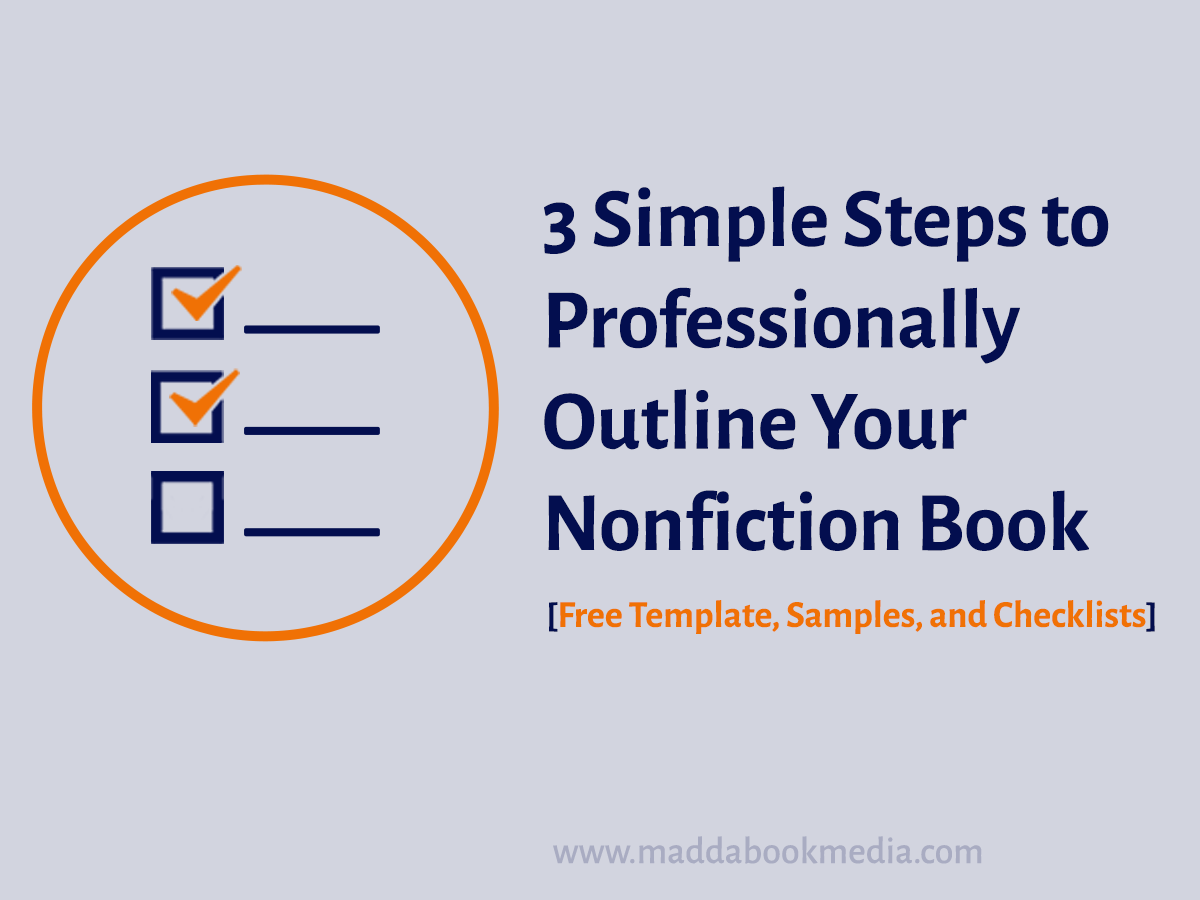Introduction
If you want to learn how to outline a book professionally, start with this all-important tip: don’t spend more than 24 hours on your book outline. After 24 hours, at most, force yourself to start Chapter One in your book writing.
Perfectionism is a book killer. Don’t get stuck trying to write a perfect outline. You simply do not need that. Focus on achieving basic clarity.
A book outline is what it is—a tool to help you organize the most important information when writing your book. And this happens through clarity of thought. The goal is to lay out your thoughts in a simple synopsis.
With your outline, you have initial clarity enough to start the writing, not total clarity. You’ll have to get into your first draft to unpack all your book has to offer fully. And you don’t need all the answers or a perfect outline to start.
Basic clarity is enough. Plus, your outline improves as your book grows, and you will always have ample time to go back occasionally and tweak your outline some more.
Once you nail the basics clearly, hit the ground running. That will prevent stalling and procrastination. Plus, if it took you more than 24 hours, there’s something you’re not doing right. Seek free professional assistance here.
Every outlining process starts with a book idea. After picking your book-worthy idea, your next step is to decide who your audience is and what your book will do for them.
Usually, at Madda, we help our authors with a free initial clarity call, and by the time they’re off the phone with us, they have enough clarity to commence. Plus, we offer guidance from outlining to the book’s final release.
Our outline template has three main steps:
- Primer Details (pre-writing): book title, positioning, objectives, audience sensibilities, and theme
- First Draft (writing stage): table of contents and book content brainstorming
- Draft Structure (post-writing): template for organizing your first draft
Together, all three sections form a concise book outline.
Now, let’s outline your book.
Step 1: Primer Details
1. Decide on your target audience and book objectives
Also, with our book outline method, used by 500+ authors, the details about your audience come before the book idea itself. That’s intentionally done to remind authors that your audience matters most.
To describe your audience, answer the following questions.
2. Who will interact with and benefit from your book the most?
Be super clear on who your ideal reader is. Don’t leave it to chance. And definitely avoid the “my book is for everyone in the world” pitfall.
To achieve this, start with a quality or interest that makes your ideal reader unique, e.g., “Stay-at-home single moms in Southern Nigeria seeking savvy financial management tips.”
Then proceed to develop a profile for your ideal readers. Start with the demography, such as age, location, religion, profession, position, industry, personality, motivations, goals, and frustrations. List all that comes to mind.
3. Describe the problem you’re solving through your book and how it affects your ideal reader.
Say, you want to write a book on long-term investment habits. Or on dieting. Or a book on dating essentials for single, high-flying businesspeople. What benefits will you offer them through your book?
Will they learn how to organize their finances better and plan their future? Will they gain a new perspective on dieting and know how to do it in a fun way? Will they gain confidence in their self-image and dress better while spending less? Write down your solution.
A good book’s power is not in its flowery language or high-sounding words but in how it solves the reader’s problem.
When a reader picks a nonfiction book, the odds are they have a need or pain, and they assume your book will efficiently solve it for them.
You don’t want to disappoint them.
Don’t write a book if you want to rant about why a recent social media hype wasn’t worth it. That’s what social media is for. Maybe a blog post, at best.
But if you set out to write a nonfiction book, ensure every chapter supplies a clear answer to a real need for a particular audience.
4. What will a published book do for you, the author?
Most authors find this part hard to deal with. Your book can get you your heart desires. Don’t shy away from this truth. But don’t also write, I want to sell a million copies on the first day.
Focus on goals that align with your objective of solving the readers’ problem. Also, leave them within the range of business or personal expectations depending on whether your book is a knowledge-share or memoir.
Step 2: First Draft
You’re now ready for your table of contents and book content brainstorming at this stage. But first, let’s outline your core book idea or book theme. Start by discussing how your core message works, and how it will solve for your ideal readers.
1. Summary Method
Summarise your idea in 3 to 5 sentences (150 words max). Ensure you adapt it to the specifics of your audience and objectives.
I want to write a book on the HR profession to teach people in HR the process and benefits of starting their HR firm.
Don’t write something like that. It’s not well-stated, and it’s not clear enough. That means it will not lead to a great book. Try saying instead:
I will write a book that offers a step-by-step guide to top-level HR executives seeking to launch their own firms. I will demystify the process by sharing the testimonials and roadmaps of successful HR professionals I have helped.
By learning the applicable laws and regulations, the reader will have peace of mind knowing they won’t need to break any rules. Thus, they will garner confidence and permission to start their own firm. They’ll be less afraid of failure as they have strategies to mitigate the risk of starting a business.
This will ultimately lead to their self-fulfillment—by getting a better lifestyle, more time for self-care, flexibility to be available for family and friends, the freedom and autonomy to practice the type of HR they love, the ability to benefit from the fruits of their hard labor, and recognition as a leader in their community.
That is a rounded and book-worthy idea targeted to a particular micro tribe of people (top-level HR execs).
There is also a plan on how to execute the writing. The reader gets clear solutions to a real problem and enjoys substantial benefits—all in about 150 words.
That sounds like a book anyone in that audience niche would want to read.
2. Frame a Problem Statement
Another approach to book ideas is to state an apparent problem and the viable solution you’re offering.
Bad sample idea: Creatives usually struggle with getting hired. I want to write a book that teaches how I win my own clients.
Please don’t put it that way because it’s unclear and unspecific. You need an article or two, not a whole book, to explain how you win clients.
Here’s something better:
I will use [my book title] to target mid-level freelance creatives who work from home and struggle to land gigs due to their juggling between day-to-day living and business demands.
Because they’re not giving their jobs the required concentration, they’re years behind on the latest. So, I will start by walking them through the recent changes in the industry and how it directly applies to their business.
I will also show them work-from-home essentials and ethics, tips, and tricks. Thus, they can balance life and be productive—a vital element of retaining hires. Then, I’ll teach my feasible, “cost-free” marketing process they can apply using a mobile device from anywhere.
This version is more of an idea for a book. It is not perfect, but it’s enough initial clarity to start with. Remember, more clarity will unfold during your drafting stage.
Book Chapters
A chapter is a main point or sub-theme that you can develop into helpful content. Usually, it can stand alone within your book and is a crucial step in the process you’re offering.
Call this list of main items and subpoints your table of contents (TOC). In other words, the potential chapters of your soon-coming book. Move on to adding a one-sentence summary explaining each chapter or main point.
You may also outline relevant anecdotes, narratives, testimonials, or analogies to buttress each chapter.
By now, you’re already into your book chapters brainstorming. Here are three practical and fast ways to brainstorm your chapters.
How to Brainstorm Chapter Texts
- Brainstorm as a workshop presentation
- Brainstorm as one-to-one coaching with a dear friend in dire need
- Brainstorm as you teaching your book to a tiny (savvy) audience
Could you tell that you quickly settled for the method you’re more comfortable with? That’s the idea. Find what works for you. And stick with it. Chances are, it will work for your audience.
Writing a nonfiction book means you have studied or practiced in that line of work. So, you have much to say.
You can’t write a prescriptive legal book to guide C-level execs who act in the social impact space if you only had experience coaching a football team.
So, imagine you were speaking to a live or online audience on your book’s subject; what would you need to tell them?
How would you introduce, build, and conclude your topic? Would the information you’re delivering have helped them solve the problem that brought them to listen to you?
Or, if you had a PowerPoint presentation at a staff meeting, or your team, on your book topic, how would you have organized your points?
How would you discuss the aspects of your subject matter if your listeners were intelligent but new to it?
Always remember to add key audience takeaways. A chapter becomes relevant stand-alone content when there’s a key analogy and takeaway.
In the end, your list of key chapter takeaways should add up to an overall stepwise, viable book solution.
Here at the end of this step’s another approach: think of your book as you helping a very dear friend who’s in [the problem you want to tackle in your book]. His life is wrecked, and he has no joy.
But you have the solution. And you want to help him figure out the problem, fix it, and move on happily.
What would you say to that friend? How would you present the points they’d need to learn to get out of the mess and have their life back in order?
Are there likely areas of confusion? What helpful insights will solve their mess and build up to a feasible solution?
Note that you’re not writing out your book yet. You’re only brainstorming what to write on. So, try not to focus on the sentences and fine details. Keep your mind on the summary of the main points.
How many chapters does my book need?
Lastly, most people ask: How many chapters should there be in my book? This shouldn’t be hard.
Only one rule works: follow your guts. Put yourself in your audience’s shoes and ask yourself, how much information would I have needed to solve this problem?
However, best practice puts it anywhere from 5 to 15 chapters. That’s not a rigid rule; it’s just what’s been mostly done.
Fewer than five or more than fifteen chapters isn’t wrong. It’s not common within the broad genre of personal development and business help books.
To the question: How many chapters should there be in my book? The most important tip is to focus on the amount of information your target reader needs to be well impacted.
Don’t hold back or offer too little. Don’t deliver unneeded excesses. And you’re just good.
This clue works for both individual chapter lengths and the overall chapters your book needs.
We believe the right book length is long enough to explore a powerful idea without consulting another guide but short enough to read in a single sitting (somewhere between 25k to 65k words depending on the topic and audience need).
So, a chapter mainly discusses a significant point, or it is an exposition of one of the steps in your book when supplying the answers the reader is asking.
It could be anywhere from less than 1k to more than 5k words. What matters is that you are concise and make sense while solving a need.
Step 3: Book Process
This part is not as straightforward as it seems. The most logical line of action here would be to reach out to one of our book strategists. Get on our free book consultation call and receive professional guidance on your book process.
Meanwhile, here’s the lowdown on it. Make sound choices that work best for your book type, help you reach your specific audience, and help you achieve your objective for writing in the first place.
Your book process is more about the commercial decisions of your book project, and it should include details like print cost on commercial offset, amount of marketing, and your chosen outlets.
Also, detail your book launch plan if you need one—the timeline for your project with designations and deliverables for each milestone.
Add up the names and contacts of persons involved in your project.
Don’t forget book ads and pricing.
All marketing plans and decisions go in here.
One last thing: in book publishing, you get what your money can buy.
Authors seeking to self-publish their books commonly look out for free and easy means.
But if you must nail a great book, be ready to spend precious time and resources.
Things like the perfect author photo or headshot, quality editing, professional book design, book ads, and more are inevitable if you want to signal that your book is worth reading.
The seriousness you put into it equals how seriously your audience will receive you and your book.




